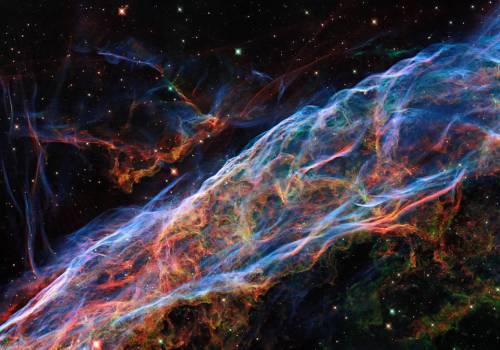
Scientists at the Hubble Space Telescope have released a reworked image of the beautiful Veil Nebula, showing threads of ionized gas winding through space.
The Veil Nebula was previously imaged by Hubble, resulting in one of the telescope’s most famous images. This original image was shared in 2015, but since then image processing techniques have improved to such a degree that researchers can use these new techniques to find out more information about an older subject. The Hubble researchers ran the original Veil Nebula image through a newer set of image processing filters to show more details in the image than were previously visible.
“To create this colorful image, observations were taken by Hubble’s Wide Field Camera 3 instrument using five different filters,” Hubble scientists wrote in a statement describing the new image. “The new post-processing methods have further enhanced details of emissions from doubly ionized oxygen (seen here in blues), ionized hydrogen, and ionized nitrogen (seen here in reds).”
The Veil Nebula is located 2,100 light-years away in the constellation of Cygnus (The Swan). Even though the nebula is large, it is in fact just one small part of a much larger formation called the Cygnus Loop. The Cygnus Loop is the remnant that was left over when a star 20 times the mass of our sun went supernova, exploding outward in a dramatic phase of the end of its life. This explosion pushed dust and gas outward in a huge shockwave, creating the loop. This explosion happened around 10,000 years ago, and the remnant has since expanded 60 light-years outward from its original detonation.
The Veil Nebula is the visible part of the Cygnus Loop, although the Hubble photo only shows a small part of it. The delicate filaments of gas visible in the Veil Nebula have made it a favorite example of the beauty of space.
Editors' Recommendations
- James Webb captures the edge of the beautiful Horsehead Nebula
- Hubble discovers over 1,000 new asteroids thanks to photobombing
- This beautiful nebula holds a starry mystery at its heart
- Hubble captures the dramatic jets of a baby star
- Hubble images the spooky Spider Galaxy